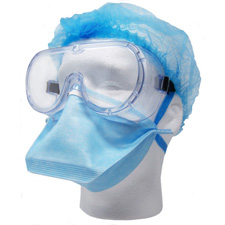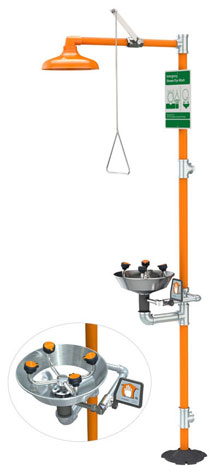



Find all of your laboratory and workplace safety supplies at Safety Emporium!
 whmis |
 Glossary Index |
 ACC |
| MSDS Topics |
Free Sites | FAQ's | Regulations | Glossary | Software | Suppliers |
| Books | Forum | Poll | Fun stuff | Quiz | Store | |
| Understand your MSDS with the MS-Demystifier | Search ALL our MSDS info | |||||

Get your US-manufactured NIOSH-approved N95 surgical respirators and more from Safety Emporium.
The Wilson RISK Scale of Material Hazards was a numeric rating system that assessed the following acute hazards:
This system was unique to Material Safety Data Sheets (MSDSs) produced by New-York based Genium Publishing Corporation, which, from about 1995 to 2020, was a commercial publisher of hazardous materials information and MSDSs. In 2002, the firm became The Genium Group Inc., but it appears the company may have gone defunct in 2020.
The numbers on the Wilson RISK Scale ranged from 1 (or possibly 0) to 4 with 1 being the least hazard and 4 being the greatest hazard. In this context, it worked similarly to the HMIS and NFPA hazard rating systems.
Genium's web site once stated that the ratings represent "a material's degree of hazard based on documented values and/or the best judgments of certified industrial hygienists." However, we have found virtually no other publicly-accessible information about the scale itself or how one would assign RISK ratings to various substances. We tried contacting Genium on more than one occasion and received no reply. Based on a single reference (under Further Reading below), it appears these were the rating criteria for the scale:
| Rating | Reactivity |
| 1 | Stable at room temperature; may be unstable at elevated temperatures. |
| 2 | Unstable; may under-go rapid chemical change. Will not detonate. |
| 3 | Capable of detonation explosive decomposition or reaction but required heat or other agent to initiate these. |
| 4 | Readily capable of detonation or explosive decomposition or reaction at room temperature. |
| Rating | Inhalation |
| 1 | TLV >500 ppm (vapor) or >10 mg/m3 (solid) |
| 2 | TLV 101 to 500 ppm (vapor) or 1.1 to 10 mg/m3 (solid) |
| 3 | TLV 11 to 100 ppm (vapor) or 0.11 to 1.0 mg/m3 (solid) |
| 4 | TLV < 10 ppm (vapor) or < 0.1 mg/m3 (solid) |
| Rating | Skin Contact |
| 1 | Slight irritation; no tissue damage. |
| 2 | Mild irritation; tissue damage. |
| 3 | Severe irritation; tissue corrosion within short time period. |
| 4 | Corrosive to skin on contact. |
| Rating | Kindling |
| 1 | Flash point > 200 °F |
| 2 | Flash point 101 to 199 °F |
| 3 | Flash point 73 to 100 °F |
| 4 | Flash point < 73 °F |

Safety Emporium carries all kinds of eye/face washes, safety showers, drench hoses and more.
See above. This scale was unique to MSDS's produced by Genium Publishing Corporation. We find the Wilson RISK system unacceptable because of its proprietary nature and because the hazard classification system required by OHSA's Hazard Communication Standard has made this system obsolete.
In 2010, we conducted a random Google search of various Genium MSDS's, and it appears that Genium was either no longer using it as a standard part of their authoring suite or only used it for certain substances. By 2020, we could no longer find it used on any current SDS or safety-related document.
Thus, it appears the Wilson RISK scale is long-defunct at this point. If you have a sheet with this information on it, it was probably authored well before the current version of the Hazard Communication Standard took effect, and is likely obsolete.
We have found precisely one document that explained the criteria for the RISK scale rating (the source of the tables presented above).
See also: CHIP, flammable, HMIS, NFPA, useless abbreviations.
Additional definitions from Google and OneLook.
Entry last updated: Tuesday, February 8, 2022. This page is copyright 2000-2025 by ILPI. Unauthorized duplication or posting on other web sites is expressly prohibited. Send suggestions, comments, and new entry desires (include the URL if applicable) to us by email.
Disclaimer: The information contained herein is believed to be true and accurate, however ILPI makes no guarantees concerning the veracity of any statement. Use of any information on this page is at the reader's own risk. ILPI strongly encourages the reader to consult the appropriate local, state and federal agencies concerning the matters discussed herein.